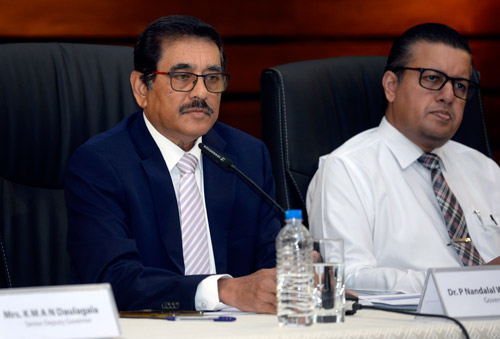Central Bank shifts to single policy rate amid debt restructure

Dr. Nandalal Weerasinghe (left) and Assistant Governor Dr. C. Amarasekara. Pic by Priyanka Samaraweera
The Central Bank of Sri Lanka (CB) is planning to replace its current dual policy rates with a single policy rate by the end of the year.
This change, recommended by the International Monetary Fund (IMF), aims to improve the clarity and effectiveness of the country’s monetary policy. Governor Nandalal Weerasinghe confirmed this during a monetary policy briefing on Friday, stating that the shift will make monetary decisions easier to implement.
Currently, CB uses two rates—the Standing Deposit Facility Rate (SDFR) and Standing Lending Facility Rate (SLFR)—to guide monetary policy.
With IMF technical assistance, a simplified approach using a single rate has been designed to provide clearer market signals. The governor emphasised that this move is crucial for maintaining the inflation target of 5 per cent, with a possible 2 per cent variation, over the next three years.
Regarding Sri Lanka’s ongoing debt restructuring, Dr. Weerasinghe shared updates on the process, which is close to completion.
The country is negotiating with international bondholders, local creditors, and the Asian Development Bank (ADB).
An agreement in principle has been reached, and a bond exchange is expected in six to eight weeks if the government sticks to the existing debt sustainability analysis (DSA).
The final decision on whether to continue with the current DSA or renegotiate will be made by the Ministry of Finance, not CB, he said adding that the restructuring process is seen as crucial for securing long-term economic stability and further support from the IMF under its Extended Fund Facility (EFF).
Sri Lanka’s economy showed significant growth in 2024, with a 4.7 per cent increase in the second quarter following a 5.3 per cent rise in the first quarter.
Inflation, which has been a major concern, has fallen below 5 per cent, largely due to lower fuel, electricity, and food prices. The CB expects inflation to stay low in the coming months but anticipates it may temporarily exceed 5 per cent by late 2025.
Sri Lanka’s trade deficit widened as imports grew faster than exports, but tourism and remittances helped strengthen the country’s financial position.
The Sri Lankan rupee appreciated by 7 per cent against the US dollar in 2024, and the CB increased foreign reserves to US$6 billion by August 2024. The ongoing debt restructuring and IMF support are expected to further stabilise Sri Lanka’s external finances.
Hitad.lk has you covered with quality used or brand new cars for sale that are budget friendly yet reliable! Now is the time to sell your old ride for something more attractive to today's modern automotive market demands. Browse through our selection of affordable options now on Hitad.lk before deciding on what will work best for you!


